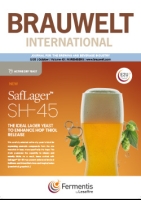Reduced Xanthohumol Recovery after Solid Phase Extraction of Dark Beers
In wort and beer the hop polyphenol xanthohumol (XN) is often determined after solid phase extraction (SPE). Recently researchers described substances in roasted malts that help to enrich XN in dark beers. The carrier effect that reduces losses during beer production may influence the SPE as well. We investigated the XN recovery in dark beer samples with and without SPE sample preparation. In SPE eluates the XN recovery significantly decreased with increasing XN content compared to directly injected samples. Experiments on XN recovery in SPE passes repeatedly treated by SPE showed that this is not due to an overload of the sorbent. The use of SPE prior to XN determination in samples containing roasted substances proved to be inefficient compared to direct injection.
BrewingScience - Monatsschrift für Brauwissenschaft, 62 (July/August 2009), pp. 95-99
trans-Piceid, cis-piceid and trans-resveratrol contents of hop cones and hop pellets from six American varieties (harvest 2004) were monitored by RP-HPLC-APCI(+)-MS/MS over 12 months of storage. trans-Resveratrol, cis-piceid and trans-piceid were found in all samples. After 8 months of storage, the overall stilbene content was decreased in the same range whatever the conditioning. Absent in fresh hop cones or pellets, cis-resveratrol was released from cis-piceid in all stored samples. cis-Resveratrol concentration revealed very interesting for assessing hop freshness.
BrewingScience - Monatsschrift für Brauwissenschaft, 62 (July/August 2009), pp. 141-146
On going research further substantiate that consumption of whole grains and grain-based products is associated with health benefits and risk reduction of chronic diseases. Epidemiological studies on these cereals continue to generate an increasing interest on cereal products. This attention also concerns the beverage industry and in the present study, more specifically, malt and beer production, connected with an expansion of the market for gluten free beers. A declaration as an ecological and natural produced good is willingly carried out by the producers. Malted cereals will be appropriate for that kind of declaration because, for brewing purposes, suited malt will offer a good fermented product derived from a simple and well-known technology. More importantly, easy availability is an essential advantage.
Nelson Sauvin (NS) is a unique hop cultivar that gives a specific flavor (exotic fruit-like, Sauvignon Blanc wine-like) to finished beers. We have attempted to identify the specific flavor compounds derived from NS. First, isobutyric esters, including 2-methylbutyl isobutyrate (2MIB), have been found in the beers used with NS (NS product). These compounds had a green apple-like and/or apricot-like flavor. We next focused on certain volatile thiols that are well known to contribute to wine flavors, especially Sauvignon Blanc, and identified two new volatile thiols, 3-sulfanyl-4-methylpentan-1-ol (3S4MP) and 3-sulfanyl-4-methylpentyl acetate (3S4MPA), having a grapefruit-like and/or rhubarb odor, similar to that of Sauvignon Blanc..
The complex phenomenon of gushing occurring in carbonized beverages has been investigated in order to better understand the mechanism and to give input for further research to introduce preventive measures for the industry. The knowledge that microbubbles are stabilized through surface active substances, and in this form can induce gushing, was used to examine a selection of representative surfactants. For the analysis, a particle size distribution method was used which enabled to detect particles at nanometer level, starting from 0.8 nm onwards. The experiments using pure aliphatic surfactants (DTAC, TTAC, CTAC, ODTABr, CPC, SDS, and Tween 20) revealed that only CTAC, solved in CO2 containing table water at 2 g/l (above the critical micellar concentration), induced gushing..
The official German 2009 hop crop estimates were published on August 19th. Following please find those estimates as well as the final world hop crop figures
Avangard Malz AG was using an electromechanical rope system to measure material levels. This system made it difficult to measure the complete range of the silo. Operators wanted to obtain reliable continuous level measurement especially during the filling cycles to maximize the silo’s storage capacity. A non-contacting solution was preferred to avoid material bulidup and lower maintenance costs.
It has already been successfully tested in the laboratory. Now, the first installation in a brewery confirms the advantages of whole grain conditioning also in the field. This process, jointly developed by Buhler and Ziemann and now also patented, allows the brewing capacity to be increased as well as the beer quality to be improved without affecting the inherent taste of the beer. Large and small breweries aiming at reducing their production time and cutting their costs will greatly profit from this new process.
In order to achieve a perceptible hop aroma in beer, late hop additions near the end of the boil or in the whirlpool have become standard practice. It is common knowledge that the bittering substances contained in hops fluctuate from year to year, and, as part of standard brewhouse practices, this is taken into account when calculating hop additions. However, the impact of the fluctuations in hop aroma compounds stemming from seasonal and varietal differences on the beer are rarely taken into consideration, to such an extent that this sometimes leads to significant variation in sensory quality.
In 2008, the 34th seminar for brewers and maltsters took place at the Pilsener Urquell Brewery from the 22nd to the 24th of October. Around 300 people from the Czech Republic as well as from neighboring countries took the opportunity to meet with colleagues and listen to the presentations.
There are several options available for brewers to produce beers with hop aroma.
Spring 2008 witnessed an acreage increase that had not been seen for over thirty years.


